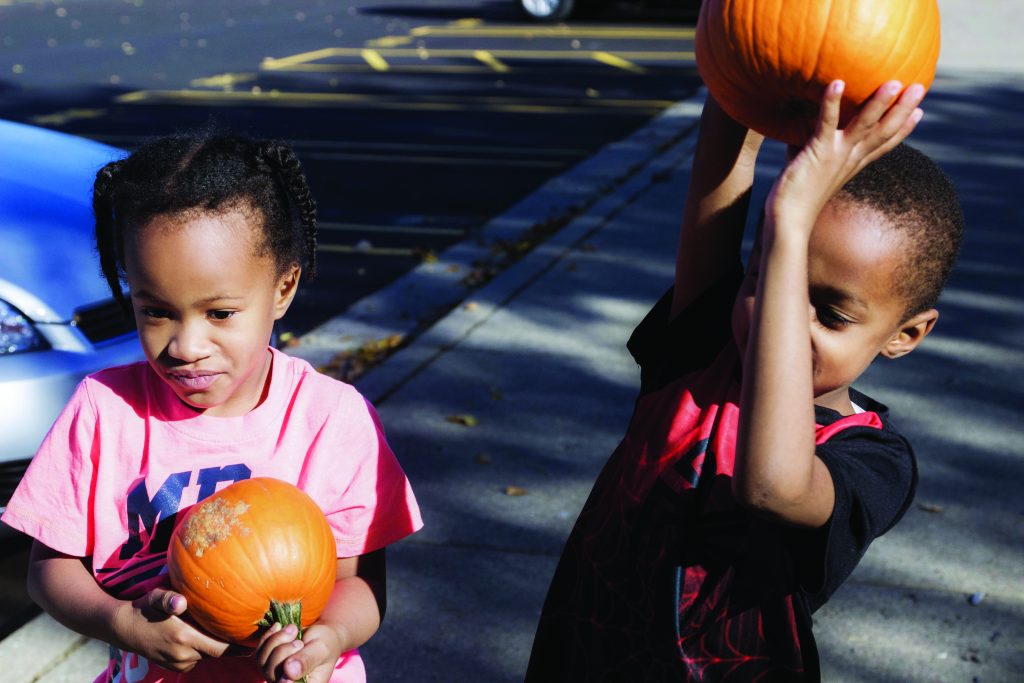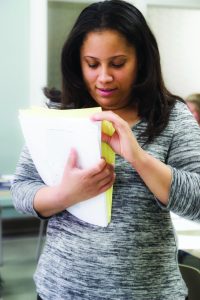Jas was taking a break from studying for her exam in feminist theory. She turned on her television guilty pleasure, “Shameless,” a show about a dysfunctional family that she only watches alone.
“Don’t you need to do your homework?” a voice chimed in from the next room. Jas sighed as the figure administering the nagging approached her on the couch. She peered down at her 4-year-old son, who playfully reminded her of her educational responsibilities in hopes of taking over the remote control.
Jasmia Hamilton, 22, wouldn’t miss class because she overslept or couldn’t recover from a late night of partying. Her excuse would be quite different from the typical college student and would likely involve caring for one of her sick children.
Although Hamilton isn’t what comes to mind as a traditional student, there is a large population of student parents who have stories similar to hers. Of the 4.8 million college-age student parents in the United States, many don’t have access to needed child care. As a result, only one-third are able to attain a degree or certificate within six years of enrollment, according to the Institute for Women’s Policy Research.
Hamilton gave birth to her two sons when she was in high school and had her heart set on defying society’s judgment against teen moms. She told herself she would not become a single mother confined to her home to take care of her children. Instead she would pursue a bachelor’s followed by a master’s degree at UW-Madison while working as a teaching assistant and raising her two boys.
Because she’s crazy. At least, that’s how she introduces herself in social situations.
“When people see me, they say ‘Jasmia, you have two kids and a partner, and you’re in school. … How do you make things work?’” she says. “And I say, ‘It’s because I’m crazy — like how else would I make it work?’”
She also credits her support system, her partner Rayvell Gillard, as one of the main reasons she was able to complete her bachelor’s degree in gender and women’s studies in just three years. Now pursuing her master’s degree in gender and women’s studies, she is able to stay unusually calm in comparison to most college students who are overloaded with responsibilities.
Jen Templin, parent resource specialist at UW-Madison’s Office of Child Care and Family Resources, says she can’t imagine how student parents get through the day when it’s difficult enough as a college student just to take care of yourself. “I’ve been a mom and I’ve been a student, and I can’t imagine combining those two things,” Templin says.
But student parents find a way make it work. “They are so dedicated, and it’s so good for their children to watch them go through that,” Templin says. “When they get older and they can look back at what their parent went through when they were little — and how they took care of them and how they were trying to make a better life for their family — it’ll be more meaningful.”
Candice Wagener, communications manager for the Office of Child Care and Family Resources, describes student parents as a unique breed of people who have their own aspirations and motivations, but also have aspirations for their children.
She says they’re trying to provide the best life for their kids and also be their role model.
“They’re not giving up; they’re pushing through against so many obstacles,” Wagener says. “I think that’s really a true commitment and a true way to show your kids that if you work your hardest, it will pay off in the end.”
“Riding off into the sunset”
It was Friday night, and Javell wasn’t feeling well. After taking the boys home from martial arts practice the next day, Hamilton noticed a skin rash on both Javell and Rayvell Jr. She rushed them to the emergency room, where the doctor explained the illness was highly contagious. Unfortunately, the boys would not attend their classmate’s birthday party later that afternoon.

On Sunday the boys slept and relaxed while Hamilton emailed and called the day care and school to notify teachers that the boys would be staying home the next day. Once those items were checked off Hamilton’s to-do list, she put her feet up and took advantage of what she calls her “academic recess day.” This is time where she “simply [holds herself] accountable for sanity and repair.”
Break times like this are necessary for student parents who have a reputation for being hard-working, passionate people with awe-inspiring planning and organizational skills. But a footnote to their success is that they became pregnant at a young age.
“A lot of the literature about teenage pregnancy is that outcomes are bad,” Hamilton says. She explains society tends to share this negative perception just because young people are having sex, when really the unfortunate outcomes are related to young parents being impoverished.
Teen pregnancy rates in the United States have fallen to a historic low in recent years, according to the Centers for Disease Control and Prevention, possibly due to increases in birth control use or delays and reductions in sexual activity. In 2014, birth rates among teens of all ages were on the decline, with about 24 births for every 1,000 teenagers between the ages of 15 and 19.
According to the CDC’s National Campaign to Prevent Teen and Unplanned Pregnancy, teen mothers have fewer economic opportunities and earnings after having a child in comparison to their peers. Although over 60 percent of teen mothers receive some form of public benefits within the first year their child is born, two-thirds of teen mothers who move out of their family household live below the poverty level.
These economic disparities are problematic, but Hamilton believes the traditional ways of thinking about sex in education and what society defines as “normal” life trajectories are equally important issues.
“For most people the understanding is that to be a student parent is also a burden,” she says. “But I think if we go beyond that stereotype that a life course needs to go in the pattern of: you finish college, you get married, then you have children and you ride off into the sunset.”
Then, she adds, we can think of many ways in which student parents are being positively affected. For instance, Hamilton explains the dual responsibility of being a mother and a student has allowed her to develop better time management skills
Wagener says understanding that this trajectory wasn’t right for everyone is one of the most important lessons she has learned working at the Office of Child Care and Family Resources, where she encounters students in all stages of life.
“Being in this role and meeting more people who are students and also have a family to raise … [while] trying to complete school — that’s a huge undertaking,” she says. “[Families] come into our office looking for support in [both of those roles], and I feel like that’s a huge need that we need to be there to fill.”
As a teen mother, Hamilton’s decision to pursue a college degree following high school graduation is a rarity. The CDC reports that only 38 percent of teen girls who have a child before age 18 earn their high school diploma by age 22. Furthermore, nearly one-third of teen girls who have dropped out of high school cite pregnancy or parenthood as a reason.
Hamilton made the decision to be the first in her family to attend a four-year university — all while raising two young boys — because she wanted to defy the norm and prove to herself and others that she could be successful as a nontraditional student.
“For me, I had to acknowledge that there was something else that I could do in my life to serve as a role model for my boys,” Hamilton says. “But also [I wanted to be a role model for] the scores of teen parents who are automatically shut out of opportunity, even if they are labeled ‘bright and intelligent.’ They have been cast away because of their sexual activity.”
“Put it on the backburner”
When the boys returned to school on Tuesday, Rayvell Jr. was upset because some of his friends believed he lied about being sick and missed the birthday party on purpose. Hamilton calmed him down and told him to stick up for himself.
After Rayvell Jr. was sufficiently comforted, she let the boys watch television. She brought them a snack to disrupt their trance-like staring at the screen, amazed at the Power Rangers’ acrobatic abilities.
After their allotted one episode per night, Hamilton assigned the boys to go read a book together while she finished making dinner. She says she often jokes that you only have to “get it right once,” meaning that siblings close in age can and often will teach each other.
Although Rayvell Jr. and Javell can often occupy themselves, Hamilton and other student parents need child-care services so they can attend classes and have time alone to study. But when these services nearly double the amount they are already paying for college tuition, it seems almost unfathomable.
“Care is expensive — particularly if you are wanting to treat your employees as well as [you] can in this underpaid field,” says Amy Welk, director of Bernie’s Place, where Hamilton’s children attend day care.
Children can begin attending day care at 6 weeks old, with full-time care rates ranging from an annual cost of about $21,000 for infants and nearly $15,000 for preschoolers. Many parents have to find a way to pay this daunting amount of money when they don’t have a job, because their schoolwork fully occupies their time — and their children command any time left over.
Bernie’s receives financial support from its affiliation with the university, but this isn’t enough to offset the cost of care and ensure its affordability for student parents.
The Office of Child Care and Family Resources can help offset costs, serving 200 to 250 students per semester through the Child Care Tuition Assistance Program. Students must demonstrate their financial need and be enrolled full-time at UW–Madison. The main goals of the program are to encourage students to choose consistent, high-quality child care and enable them to focus on academics rather than the financial burden of care.
The office can cover 40 to 50 percent of child care costs for students through the tuition assistance program.
“But even covering 50 percent of care, [the payment] is still unobtainable,” Templin says.
Of the students who receive financial assistance from the child care office, about 30 students per semester qualify for Access for Infants and Mothers, a federal aid package that allows student parents to only pay 5 to 30 percent of their child care fees.
“Without [these programs], they couldn’t afford to be here, and they couldn’t afford to finish their degrees,” Welk says. “That’s just the reality of it.”
Hamilton says financial assistance has ensured her sons receive quality care and significantly reduced her stress level.
“It allowed me to focus on school and be on top of things and not have that on the forefront of my mind,” she says. “I could put it on the back burner.”
“We shouldn’t cast it in a negative light”
On Wednesday when the boys were finally feeling better, Hamilton walked up the stairs of Chamberlin Hall to teach her three consecutive discussion sections. Today marked the midpoint of the semester, and her students had just taken the midterm exam. She prepared to administer the “don’t be nervous about your grade — there is hope in the class and in the world” speech.
That tends to be Hamilton’s outlook for life in general. Despite the obstacles she has faced being a full-time student and raising two boys, she emphasizes how positive this experience has been.
“I don’t want to sugarcoat that there are hardships that student parents face, including myself,” she says. “But I think that we shouldn’t cast it necessarily in a negative light. Because people do benefit from the experience of…being engaged in the education process as their children are.”
Melissa Behling
 A native Wisconsinite hailing from Racine, Melissa will pursue a career in documentary production after graduating from UW-Madison. She believes videojournalism has the capability to inspire positive change and to give a voice to historically underrepresented communities. When she is not filming, editing or eating ice cream, Melissa loves playing the snare drum and does so professionally for the Milwaukee Bucks and Green Bay Packers.
A native Wisconsinite hailing from Racine, Melissa will pursue a career in documentary production after graduating from UW-Madison. She believes videojournalism has the capability to inspire positive change and to give a voice to historically underrepresented communities. When she is not filming, editing or eating ice cream, Melissa loves playing the snare drum and does so professionally for the Milwaukee Bucks and Green Bay Packers.


